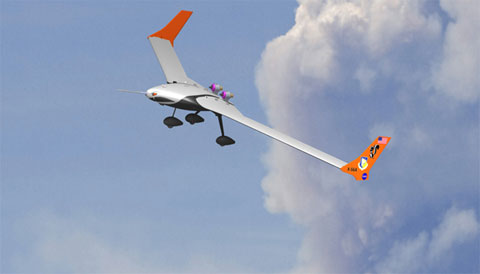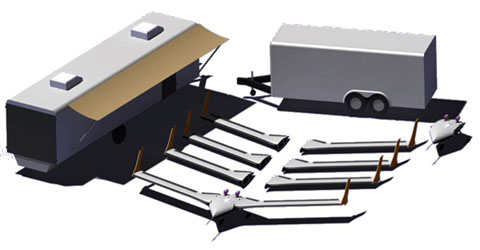
They are prepared to fly until the wings fall off, though the hope is a computer will prevent that. In case it doesn’t, engineers have adapted the ballistic recovery system installed in Cirrus aircraft for use on a series of experiments expected to start this summer in the Southern California desert.
Technology borrowed from general aviation could ultimately help foster a new generation of lightweight, highly efficient aircraft with many possible applications, including military, commercial airlines, and even GA. The rocket-powered parachute should keep the newly designed test aircraft intact should the wings fail to return from a trip to the edge of the envelope.
The Air Force Research Laboratory, working in conjunction with NASA and Lockheed Martin Skunk Works engineers, expects to spend the summer and fall flying a brand-new X-plane, the X-56A. The unmanned aircraft powered by small turbojets was designed by Lockheed Martin to test the hypothesis that a “fly-by-wire” computer system can control the phenomenon of “flutter.”
The 480-pound X-56A has the kind of long, slender wings coveted by designers seeking to develop long-range, highly efficient aircraft. High-aspect-ratio wings outperform more traditional designs in most respects, but at a cost: The interaction between aerodynamic forces and structural load forces can cause them to bend, twist, and break apart in flight. A dramatic illustration of the same basic phenomenon was filmed in 1940, when the long, narrow, steel-framed Tacoma Narrows Bridge began jumping and twisting in gale-force winds four months after the bridge opened to traffic.
In the past, designers using long, slender wings have taken one of three approaches to keep the lifting surfaces and fuselage firmly attached: sacrifice speed, increase the wing’s rigidity with a more robust structure, or use strategically located weights to balance against the forces of flutter.

AFRL Multi-utility Aeroelastic Demonstration (MAD) Program Manager Pete Flick said the goal is to reduce aircraft weight, and everything that goes with it--including fuel consumption.
“We’re trying to enable use of more efficient configurations without paying a significant structural weight penalty,” Flick said.
Instead of stronger spars, flexible wings will rely on silicon chips to stay intact.
Lockheed Martin designed the unmanned X-56A with multiple sets of high-tech wings, including a rigid version for baseline testing and flexible fiberglass wings for pushing the envelope. Computers connected to an array of sophisticated sensors will monitor each wing’s performance—and any twisting or warping—in real time, and adjust the control surfaces and a body flap mounted on the trailing edge to mitigate flutter in flight. It’s a concept refined during development of the F-117 Stealth Fighter, where aerodynamic instability was compensated for by a computer that constantly adjusts control surfaces—much faster than a human pilot is capable of—to maintain the desired attitude.
“We’re kind of going down the same path we did 20, 30 years ago with reducing the stability of some of our aircraft,” said Lockheed Martin Program Manager Ed Burnett. “We solved those problems with flight control computers.”
Lockheed Martin Deputy Program Manager Jeff Beranek said there are multiple flutter zones to contend with, the first expected to start at 95 knots. Three more “flutter zones” must be overcome as airspeed increases to the 150-knot limit of the X-56A’s test envelope.
“There’s no intention to break a wing in flight,” Beranek said, though the BRS adapted from Cirrus aircraft may come in handy. “We do understand that is a possibility.”
The engineers believe the flutter-busting technology, once proven, will make its way first into military applications. Commercial airline adaptations would likely follow. It may be a few decades before GA gets a “reward” for “lending” the parachute system, but experimental aircraft designers will likely be the first to collect.



